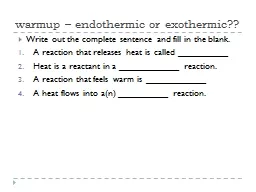

endothermic or exothermic Write out the complete sentence and fill in the blank A reaction that releases heat is called Heat is a reactant in a reaction A reaction that feels warm is ID: 421976
Download Presentation The PPT/PDF document "warmup" is the property of its rightful owner. Permission is granted to download and print the materials on this web site for personal, non-commercial use only, and to display it on your personal computer provided you do not modify the materials and that you retain all copyright notices contained in the materials. By downloading content from our website, you accept the terms of this agreement.
Slide1
warmup – endothermic or exothermic??
Write out the complete sentence and fill in the blank.
A reaction that releases heat is called __________
Heat is a reactant in a ____________ reaction.
A reaction that feels warm is ____________
A heat flows into a(n) __________ reaction.Slide2
Thermochemical Equations part II
calculate enthalpy of reactionSlide3
Objectives
to use
thermochemical equations
to
calculate
energy changes that occur in chemical reactions
to
classify
reactions as
exothermic
or
endothermicSlide4
Thermochemical Equations – concept overview
Definition: Enthalpy (H) is a measure of the heat content of a system or substance.
When chemical bonds are formed, heat leaves the system and the chemical potential energy or internal enthalpy of the system goes down, the surroundings get warm.
H is negative.
To break or destroy a chemical bond heat is required and chemical potential energy or internal enthalpy of the system goes up, the surroundings get cool.
H is positive.
When a chemical reaction takes place the enthalpies (
chemical potential heat
content) of the products will differ from the enthalpies of the reactants because they have different bondsSlide5
All Chemical reactions change the
number
and
type
of
chemical bonds
between the atoms.
2H
2(
g
)
+ O2(g) 2H2O(l)
Products have:H-O bondsthat get formed
Reactants have:
2 H-H bonds
O=O bond
that get brokenSlide6
review: Bond Dissociation Energy (BDE):
Each type of bond releases a different amount energy when it is formed and requires that same amount of energy to break it.
BDEs can be found in chemistry tables (page 448)
BDE Examples:
C = O 736 kJ/mol
H – O 464 kJ/mol
Example 1: Water
draw it:
H2O has
two
H-O bonds
Example 2: Carbon Dioxide draw it: CO2 has two C=O bondsSlide7
Enthalpy of Formation
(also called Heat of Formation)
Every
substance releases
heat (energy) when each of its bonds are formed and requires that same amount of heat to break them.
The total change in heat to form 1 mole of a substance from its constituent elements is called the enthalpy of formation. (
H
o
f
)
Enthalpies of formation (Hof) for many chemical substances can be found in tables. (textbook p316)Slide8
Enthalpy of Reaction (also called Heat of Reaction)
When a chemical reaction takes place the enthalpies (heat content) of the products will differ from the enthalpies of the reactants because they are bonded differently after the reaction.
The total change in enthalpy (
H) that occurs in all the reactants when forming all the products in a reaction is the
enthalpy of reaction
=
HSlide9
Enthalpy of Reaction (also called Heat of Reaction or
H)
If you know the enthalpy for formation (
H
o
f
) of all the products and reactants in a chemical reaction, the change in enthalpy for the reaction,
H, can be calculated easily.
If DH is negative, the reaction is exothermic and releases heat.If DH is positive, the reaction is endothermic and absorbs heat.Slide10
If the
enthalpy of products
is greater, then
D
H is positive, the reaction is endothermic.
It feels
cool.
If the
enthalpy of reactants
is greater, then
D
H is negative, the reaction is exothermic.
It feels warm.Slide11
Example 1: decomposition of hydrogen peroxide
Calculate the enthalpy of reaction for decomposition of hydrogen peroxide into oxygen and water and determine if the reaction is exothermic or endothermic.
2 H
2
O
2
→ O
2
+ 2 H
2
0
Enthalpy Hof of reactants H2O2 -187.8 kJ/molEnthalpy Hof of products O2 0.0 kJ/mol H20 -285.8 kJ/molUsing the balanced equation:
H = Slide12
Example 2: citric acid and sodium bicarbonate reaction
Calculate the enthalpy of reaction for the reaction between citric acid solution, H
3
C
6
H
5
O
7
(lemon juice) and sodium bicarbonate NaHCO
3
H3C6H5O7 + 3 NaHCO3 → 3 CO2 + 3 H2O + Na3C6H5O7 Enthalpy Ho
f of reactants Enthalpy Hof of products
H
3
C
6
H
5
O
7
-1544 kJ/mol CO
2
-393.5 kJ/mol
NaHCO
3
-951 kJ/mol H
2
O -241.8 kJ/mol
Na
3
C6H5O7 -2412.3 kJ/mol Using the balanced equation: H = Slide13
Concepts to know
Enthalpy – measure of heat content of a system or substance
Bonds forming release heat.
D
H is negative
Bonds breaking absorb heat.
D
H is positive
Enthalpy of formation for substances differ because different bonds are involved.
Ho
fEnthalpy of a reaction is the total Hof for all reactants and products. DH = (Hof products – Hof reactants)If DH is negative, the reaction is exothermic and releases heat.If DH is positive, the reaction is endothermic and absorbs heat.